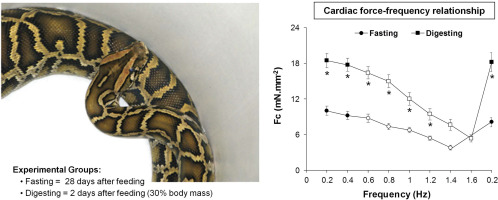当前位置:
X-MOL 学术
›
Comp. Biochem. Physiol. B Biochem. Mol. Biol.
›
论文详情
Our official English website, www.x-mol.net, welcomes your
feedback! (Note: you will need to create a separate account there.)
Effects of feeding and digestion on myocardial contractility and expression of calcium-handling proteins in Burmese pythons (Python molurus).
Comparative Biochemistry and Physiology B: Biochemistry & Molecular Biology ( IF 1.9 ) Pub Date : 2019-10-30 , DOI: 10.1016/j.cbpb.2019.110371 Eliton da Silva Vasconcelos 1 , Ana Lúcia Kalinin 1 , Rafael Correa Cipriano 1 , Samuel Dos Santos Beserra 2 , André Guelli Lopes 1 , Cléo Alcântara da Costa Leite 1 , Diana Amaral Monteiro 1
Comparative Biochemistry and Physiology B: Biochemistry & Molecular Biology ( IF 1.9 ) Pub Date : 2019-10-30 , DOI: 10.1016/j.cbpb.2019.110371 Eliton da Silva Vasconcelos 1 , Ana Lúcia Kalinin 1 , Rafael Correa Cipriano 1 , Samuel Dos Santos Beserra 2 , André Guelli Lopes 1 , Cléo Alcântara da Costa Leite 1 , Diana Amaral Monteiro 1
Affiliation

|
Pythons are important models of studies on postprandial metabolism because their physiological responses are exacerbated when digesting large prey. Prior studies of these animals have shown hypertrophy of the cardiac tissue 2 to 3 days after feeding, coinciding with the peak of the specific dynamic action (SDA), but the consequences of this remodeling in myocardial contractility have not been studied, which is the purpose of this work. Specimens of Python molurus were divided into two groups: a Digesting group (2 days after feeding, at the peak of SDA), and a Fasting group (28 days after feeding). When compared to the Fasting group, the Digesting group showed higher relative ventricular mass and calcium-handling protein expression such as sarcoplasmic reticulum Ca2+-ATPase (SERCA), phospholamban (PLB), and the Na+/Ca2+ exchanger (NCX). Digesting pythons also exhibited significant increases in the cardiac contraction force (Fc), rates of force development and relaxation, and cardiac pumping capacity. Therefore, the higher SERCA, PLB and NCX expression levels increased cytosolic Ca2+ transient amplitude, improving myofilament force. These changes are crucial to maintain cardiac output and a relatively high and continuous blood flow required by metabolic expenditure that occurs in postprandial animals.
中文翻译:

进食和消化对缅甸巨蟒(巨蟒)心肌收缩力和钙处理蛋白表达的影响。
蟒蛇是餐后代谢研究的重要模型,因为它们在消化大量猎物时会加剧其生理反应。这些动物的先前研究显示,进食后2至3天心脏组织肥大,与特定动态作用(SDA)的峰值相吻合,但尚未研究这种重构对心肌收缩力的影响,这是目的这项工作。Python软体动物的标本分为两组:消化组(进食后2天,在SDA达到峰值)和空腹组(进食后28天)。与空腹组相比,消化组显示出更高的相对心室质量和钙处理蛋白表达,例如肌浆网Ca2 + -ATPase(SERCA),phospholamban(PLB)和Na + / Ca2 +交换子(NCX)。消化的蟒蛇还表现出心脏收缩力(Fc),力量发展和放松的速率以及心脏泵血能力的显着增加。因此,更高的SERCA,PLB和NCX表达水平增加了胞浆Ca2 +的瞬时振幅,从而改善了肌丝的力量。这些变化对于维持心输出量以及餐后动物发生代谢消耗所需的相对较高和连续的血流至关重要。
更新日期:2019-10-30
中文翻译:

进食和消化对缅甸巨蟒(巨蟒)心肌收缩力和钙处理蛋白表达的影响。
蟒蛇是餐后代谢研究的重要模型,因为它们在消化大量猎物时会加剧其生理反应。这些动物的先前研究显示,进食后2至3天心脏组织肥大,与特定动态作用(SDA)的峰值相吻合,但尚未研究这种重构对心肌收缩力的影响,这是目的这项工作。Python软体动物的标本分为两组:消化组(进食后2天,在SDA达到峰值)和空腹组(进食后28天)。与空腹组相比,消化组显示出更高的相对心室质量和钙处理蛋白表达,例如肌浆网Ca2 + -ATPase(SERCA),phospholamban(PLB)和Na + / Ca2 +交换子(NCX)。消化的蟒蛇还表现出心脏收缩力(Fc),力量发展和放松的速率以及心脏泵血能力的显着增加。因此,更高的SERCA,PLB和NCX表达水平增加了胞浆Ca2 +的瞬时振幅,从而改善了肌丝的力量。这些变化对于维持心输出量以及餐后动物发生代谢消耗所需的相对较高和连续的血流至关重要。











































 京公网安备 11010802027423号
京公网安备 11010802027423号